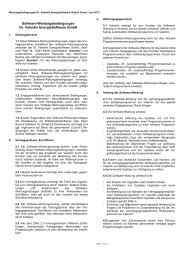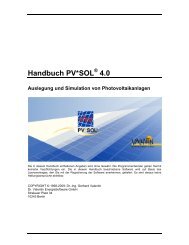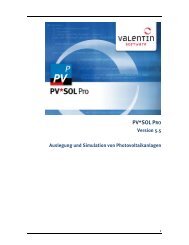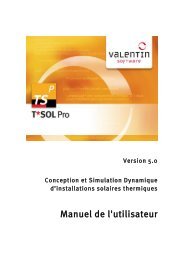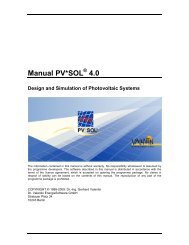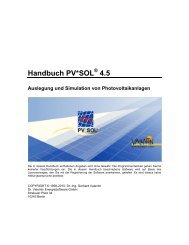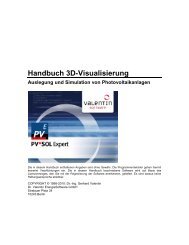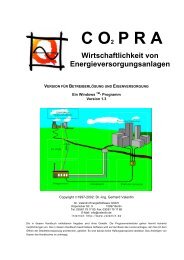PV*SOL Expert 6.0 - Manual - Valentin Software
PV*SOL Expert 6.0 - Manual - Valentin Software
PV*SOL Expert 6.0 - Manual - Valentin Software
You also want an ePaper? Increase the reach of your titles
YUMPU automatically turns print PDFs into web optimized ePapers that Google loves.
10.1.8 Losses<br />
10.1.8.1 Losses at the PV Generator<br />
System > Technical Data > Losses > Array i<br />
The array’s power output (DC side) is, along with the STC efficiency and the calculated<br />
output, determined by the part load operation, the output’s temperature dependency (see<br />
output coefficient in the PV Module dialog) and the additional losses.<br />
-> Proceed as follows:<br />
1. Enter the following losses, which occur during real system operation:<br />
o Deviation from Standard Spectrum AM 1.5:<br />
Spectral mismatch changes the module’s characteristic curve, which is<br />
measured against a standard spectrum. In Central Europe a correction<br />
factor of an annual average of 2% can be allowed for. The correction factor<br />
should be entered in the field provided.<br />
o due to Mismatch or Lesser Yield Due to Deviation from Manufacturers<br />
Info:<br />
Despite equal irradiation and temperature, different MPPs (mismatching)<br />
can occur because of production tolerances, or because the modules do not<br />
reach their full power as stated by the manufacturer (lesser yield). These<br />
kind of power losses can reach 1-5%. (This does not mean the ”mismatch<br />
effect” that occurs if differently aligned modules, ie a number of arrays, are<br />
connected to a single system inverter. These losses are defined during<br />
simulation.)<br />
o in Diodes:<br />
Losses caused by a drop in voltage by the modules’ blocking diodes can<br />
usually be ignored.<br />
o due to Pollution:<br />
Over a certain tilt angle (approx. 20%) losses caused by pollution can be<br />
ignored.<br />
2. Irradiation Gains:<br />
o Ground Reflection (albedo) is evaluated in the radiation processor. PV array<br />
irradiation is increased by the reflection of radiation on the ground or in the<br />
surrounding area. With a ground covering of snow the albedo is 80%, under<br />
normal conditions the albedo is 20%.<br />
Enter the average annual ground reflection (albedo).<br />
o Or enter the monthly albedo.<br />
3. From the system height above ground level it is possible to determine the scalar<br />
wind at system height for the dynamic Temperature Model. The wind in the<br />
climate data is measured at a height of 10 meters.<br />
Enter the height of the PV system above ground.<br />
102



